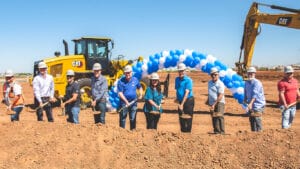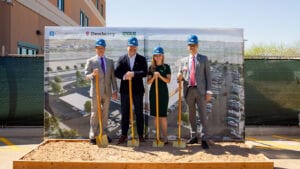When you think of construction, you might think of a man wearing a tool belt.
Picture this instead. A single mother of three, who started as a painter in 1994, found out she could learn carpentry through a free class, earn college credit and double her hourly wage.
That is what Iris Bost, a 41-year-old woman from Globe, is doing through Construction Academy, a program sponsored by the Arizona Department of Transportation.
The academy has more than 400 participants this year, 40 percent of which are women, according to Corey Foster, workforce program development manager.
In addition, Arizona State University is encouraging more women to go into management in the construction business. The university has an Advancing Women in Construction (AWIC) club with about 40 active members.
The efforts of the Construction Academy and AWIC are changing the face of construction in Arizona. And it needs to, say construction experts.
“Eventually, I hope it’s just standard that you see a female on the job site,” said Cassidy Hunter, a construction management major at ASU. “I hope that it becomes more routine or more normalized.”
Construction Academy
Bost takes Construction Academy classes through Gila Community College. The program, which has been around almost four years, offers construction training and mentoring for minorities, women, veterans and disadvantaged individuals.
“Mike West is a great instructor,” she said. “He walks us through it, helps us through it. Makes me want to continue in the construction business.”
Foster has overlooked the Construction Academy for almost two years.
In 2014, the program started off with 105 participants. Thirty eight were women, he said.
Foster added that he has seen more women playing an active role, especially because the program is customized to help people enter the construction industry with on-the-job training, skill development, mentorships and linking individuals with contractors.
Training is offered nearly all hours of the day, including weekends, he said. And all courses are customized from learning barriers to even language barriers.
“We literally hold your hand and get you connected to the contractors,” he said. “We create opportunities and we are trusted advocates for individuals. I like what we do and how we do it.”
Bost said she learned how to build houses and windows and wants to earn certification to be a flagging instructor through the Occupational Health and Safety Administration (OSHA).
Bost also said her children are completely supportive of the opportunity and are at the age where they can contribute in the house or make dinner while she is in evening classes.
“It’s hard as a single parent doing anything,” she said. “Doesn’t matter what field you’re in.”
Patricia McKinley, 39, is also a single mother who has taken advantage of ADOT’s programs.
After becoming overwhelmed with the health profession and trying to finish her nursing degree at Grand Canyon University, McKinley said she came across an article that mentioned the Construction Academy.
“What really drew me in was how easily accessible it was to obtain work,” she said. “There are so many opportunities to learn a new skill, especially for people trying to change professions.”
She said that in the future, she would like to own a construction company and partner with the state to help foster children learn a new skill.
In 2018, 80 percent of Construction Academy participants have gotten jobs right away, 65 percent of which are in heavy highway construction, according to Foster.
The 2018 rate has increased slightly from 2015, when about 74 percent of participants were hired for heavy highway projects, he added.
Advancing Women in Construction at Arizona State University
Kristine Sorensen, a senior at Arizona State University, is president of the university’s Advancing Women in Construction (AWIC) club and overlooks about 40 active members.
“Our overall mission is bringing women together and letting them feel like they have a community that surrounds them and supports them,” she said.
Sorensen emphasized AWIC’s mentorship program, which half of the active members participate in. The program provides students with an industry mentor in their desired field of construction who will help them network and develop relationships with other companies.
Sorensen said her passion is in commercial construction, and she wants to build hospitals and hotels with complex mechanical, electrical and plumbing systems.
In addition, she will be working toward a project manager position while pursuing her MBA.
Cassidy Hunter said she meets with her mentor over lunch and figures out which route she wants to take in the industry.
She said that in five years, she hopes to be at least an assistant project manager in the commercial construction or multifamily field.
“Some of the biggest struggles are sometimes people thinking we don’t know what we’re talking about,” according to Sorensen. “We’re just another participant on this team trying to see that the project goes smoothly.”
‘I kind of like being underestimated’
Sundt Construction is one of the largest general contractors in the nation that specializes in transportation and industrial, building and concrete work, according to its fact sheet.
“We’ve really made an effort in the last three to four years to be a little more organic about diversity hiring,” said Chandra Reilly, project executive of Sundt. “Putting women in managerial and executive positions.”
Sundt’s intern population this year is 24 percent women, according to Reilly.
“Our goal is to have the industry reflect the diversity that’s reflected in our clients,” she said. “Our clients are men and women of all ages and cultural backgrounds. That’s exactly what our staff looks like too.”
On the professional side, Sundt’s Southwest District is 23 percent female, Reilly said, with 15 percent non-minority women and 6 percent minority women.
Including the admin and craft workforce, Sundt is 11 percent female. Craft workforce alone, 2 percent of workers are women and more than half of them are Native American, she said.
Reilly said she has been with Sundt nearly five years. She said that the more time she spends in the industry, the more she realizes the problems of women in the construction industry are not as large as people perceive them to be.
She said it is nice to see momentum building around the subject, but part of her is very cautious.
“It is real,” she said. “There are challenges. The last thing we want to do is set ourselves so apart that integration becomes harder.”
Jennifer Donaldson, project manager at Stacy and Witbeck, Inc., has worked in the industry for 18 years and been a project manager for two.
She said she started as a field engineer, an entry level position, and worked her way up through different roles on projects and various safety, leadership and management training.
Currently, Donaldson is overlooking a $116 million job including expansion of the light rail in Mesa, she said. As the project manager, she said she is typically onsite a couple hours each week.
The project has around 30 office staff and 200 workers onsite, according to Donaldson.
Often, people mistake her for a secretary or human resources specialist, she said.
“I kind of like being underestimated,” Donaldson said, and then added that it’s nice when people realize what she can really do. “I don’t take offense to it, because it’s not personal.”
She said that at a recent company meeting, she and a co-worker gave a presentation on women and recruiting women into the industry.
Women make up half of the population, she emphasized. “For that reason alone,” she said. “It’s worth broadening the perspective of who can be in construction.”
Aside from that reason, Donaldson said women are often detail-oriented, bring a different, softer-side perspective and balance to the workforce.
While there are many girls who aren’t interested in construction, there are some out there who would be if they knew what the industry offered, according to Donaldson.
And Arizona programs are promoting the awareness and opportunities one academy, club and company at a time.






